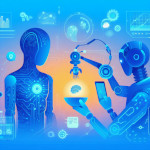
Imagine a world where software development transcends the limitations of human effort, evolving into a seamless dance between human ingenuity and artificial intelligence. This is the future of AI-assisted development, not a dystopian takeover by sentient machines, but a symbiotic partnership where humans and machines augment each other's strengths, pushing the boundaries of what software can achieve.
Augmenting Human Capabilities, Not Replacing Them
Contrary to fears of mass automation, the future of AI-assisted development lies in complementing and enhancing human skill sets. While AI excels at tedious tasks, pattern recognition, and data analysis, human developers provide invaluable creativity, strategic thinking, and domain expertise.
- Intelligent coding assistants will anticipate a developer's next move, suggesting optimal structures, completing repetitive tasks, and preventing syntax errors. Imagine never again struggling with boilerplate code or wrestling with frustrating bugs.
- Real-time feedback and optimization tools will analyze code structure and performance, flagging potential issues and suggesting improvements. Developers will have a transparent, ever-present guide ensuring code quality and efficiency.
- AI-powered design exploration platforms will generate diverse visual prototypes and user interfaces based on human input, enabling rapid iteration and exploration of possibilities. Design becomes a dynamic collaboration, fueled by human vision and AI's boundless imagination.
Beyond Automation: Proactive AI and Collaborative Creation
The future goes beyond passive assistance. AI will proactively engage in the development process, offering creative solutions and anticipating potential problems.
- Machine learning algorithms will analyze user data and project goals, suggesting novel features, identifying hidden trends, and predicting user behavior. AI becomes a strategic co-pilot, guiding development towards impactful solutions.
- Predictive failure analysis tools will anticipate potential bugs and security vulnerabilities even before they manifest. Development becomes a proactive dance, constantly evolving to stay ahead of challenges.
- AI-powered code generation engines will translate natural language descriptions and user sketches into functional code modules, empowering even non-programmers to contribute to the creative process. Development becomes truly collaborative, accessible to a wider range of voices and perspectives.
Symbiotic Partnership Requires Trust and Transparency
This future relies on a foundation of trust and transparency. Developers need to understand how AI tools make decisions, be involved in their training and calibration, and retain ultimate control over the development process.
- Explainable AI algorithms will reveal the reasoning behind suggestions and predictions, allowing developers to assess their validity and make informed decisions. Transparency becomes a cornerstone of the collaborative workflow.
- Human-in-the-loop feedback mechanisms will ensure ongoing refinement of AI models, capturing developer expertise and preventing bias or error creep. The partnership evolves and learns together, constantly improving its capabilities.
- Collaborative development environments will seamlessly integrate AI tools with traditional IDEs and workflow platforms, fostering a sense of shared ownership and responsibility. The development space becomes a unified canvas, where human and machine brushstrokes blend seamlessly.
Unlocking a New Era of Software Innovation
This symbiotic future of AI-assisted development promises to unlock a new era of software innovation.
- Increased developer productivity and output: Developers will be empowered to achieve more in less time, tackling complex projects and building ambitious solutions with unprecedented efficiency.
- Faster time-to-market and shorter development cycles: Software will be delivered to users quicker, responding to market needs and evolving trends in real-time.
- Enhanced software quality and reliability: AI-powered analysis and proactive problem detection will lead to more robust and secure software, minimizing downtime and user frustration.
- Democratization of software creation: AI tools will open doors for non-programmers to contribute to software development, injecting diverse perspectives and fostering a more inclusive tech landscape.
A Future Shaped by Choice, Not Determinism
This future is not preordained; it is shaped by our choices today. We must carefully consider the ethical implications of AI, address concerns about bias and job displacement, and ensure that technology serves humanity, not the other way around.
By fostering a culture of collaboration, building trust and transparency, and harnessing AI for good, we can harness the transformative power of AI-assisted development to build a better, more innovative future for software and the world it shapes. In this future, humans and machines dance together, not in competition, but in a breathtaking pas de deux that pushes the boundaries of what software can be.
Let us step onto this stage, embrace the potential of AI, and together, design a future where software development is not just a process, but a symphony of human and machine, composing a new era of innovation and possibility.
This article is part of the AI-Assisted Development series and includes other articles, such as:
- Revolutionizing Software Development with AI Assistance: Empowering Developers and Streamlining Processes
- The Ethics of AI-Assisted Development: Ensuring Fairness, Trustworthiness, and Transparency
- AI-Assisted Development for Citizen Developers: Bridging the Gap and Democratizing Software Creation
- AI-Assisted Development in the Enterprise: Fueling Agility, Innovation, and Competitive Advantage
- The Future of AI-Assisted Development: A Vision of Symbiotic Collaboration
